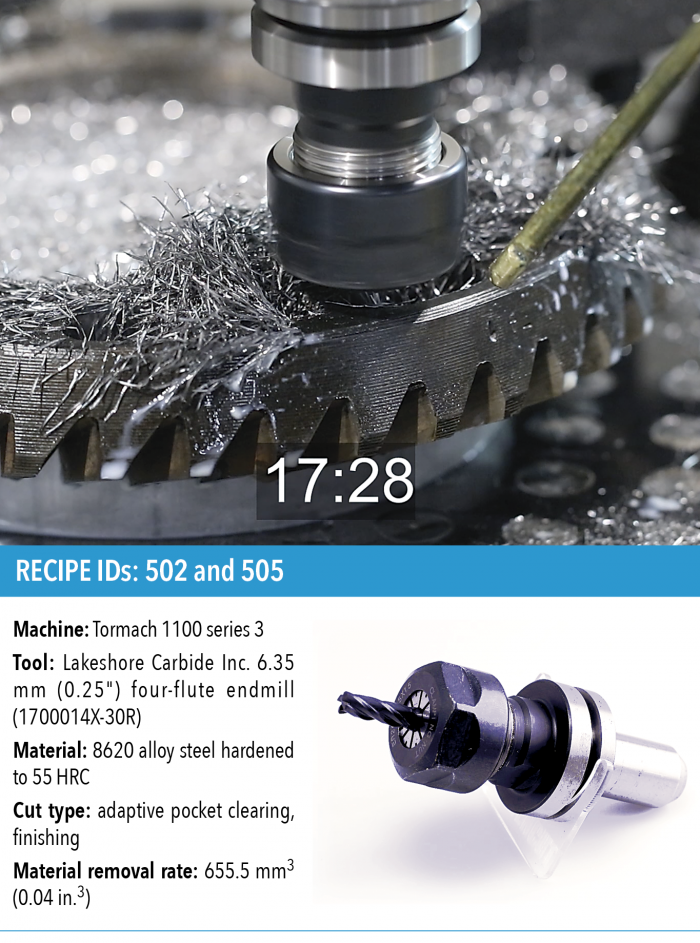Incorrect speeds and feeds are a surefire way to make terrible noises, break tools and scrap parts. Our initial attempts to machine a hardened ring gear made noises that would make any machinist shudder. Through experimentation, we optimized reliable recipes that result in an excellent surface finish and provide good tool life.
These ProvenCut recipes were performed on a Tormach 1100, a 499-kg (1,100-lb.), 1.1-kW (1.5-hp) CNC mill. It has similar capabilities as a Bridgeport. Tormach machines target the “prosumer” market and often are found in garage shops and R&D departments.
Although cutting tools designed specifically for hard milling are available, we chose a standard four-flute carbide endmill that many machinists already have on hand. Our testing focused on avoiding cutting tool vibration and ensuring that excessive heat was not created. We pushed the tool and machine to achieve an aggressive but sustainable roughing recipe and concentrated on the surface finish of the workpiece for the finishing recipe. Machining 8620 alloy steel hardened to 55 HRC can leave an outstanding surface finish with luster even when cut on a small CNC machine.

Recipe 502 was a Fusion 360 adaptive roughing strategy run at 12.2 m/min. (40 sfm) and 0.033 mm/tooth (0.0013 ipt) with a 15.875 mm (0.625") axial DOC (ap) and 0.508 mm (0.02") radial DOC (ae). Recipe 505 was a 2D contour finishing strategy run at 15.2 m/min. (50 sfm) and 0.025 mm/tooth (0.001 ipt) at the same 0.625" axial DOC to remove the 0.02" radial stock left after roughing, imparting an excellent surface finish.
Larger machine tools with more rigidity can handle higher removal rates and higher surface footage. ProvenCut recipe 81 was a great example of using a Haas VF-2 and a seven-flute, 12.7 mm (0.5") carbide endmill at 45.7 m/min. (150 sfm) to machine 60-HRC D-2 tool steel.
ProvenCut’s website provides pictures, videos and cutting information for each speed and feed recipe. You can also view a video of the machining operation at cteplus.delivr.com/29n2k
Related Glossary Terms
- computer numerical control ( CNC)
computer numerical control ( CNC)
Microprocessor-based controller dedicated to a machine tool that permits the creation or modification of parts. Programmed numerical control activates the machine’s servos and spindle drives and controls the various machining operations. See DNC, direct numerical control; NC, numerical control.
- endmill
endmill
Milling cutter held by its shank that cuts on its periphery and, if so configured, on its free end. Takes a variety of shapes (single- and double-end, roughing, ballnose and cup-end) and sizes (stub, medium, long and extra-long). Also comes with differing numbers of flutes.
- feed
feed
Rate of change of position of the tool as a whole, relative to the workpiece while cutting.
- gang cutting ( milling)
gang cutting ( milling)
Machining with several cutters mounted on a single arbor, generally for simultaneous cutting.
- milling
milling
Machining operation in which metal or other material is removed by applying power to a rotating cutter. In vertical milling, the cutting tool is mounted vertically on the spindle. In horizontal milling, the cutting tool is mounted horizontally, either directly on the spindle or on an arbor. Horizontal milling is further broken down into conventional milling, where the cutter rotates opposite the direction of feed, or “up” into the workpiece; and climb milling, where the cutter rotates in the direction of feed, or “down” into the workpiece. Milling operations include plane or surface milling, endmilling, facemilling, angle milling, form milling and profiling.
- milling machine ( mill)
milling machine ( mill)
Runs endmills and arbor-mounted milling cutters. Features include a head with a spindle that drives the cutters; a column, knee and table that provide motion in the three Cartesian axes; and a base that supports the components and houses the cutting-fluid pump and reservoir. The work is mounted on the table and fed into the rotating cutter or endmill to accomplish the milling steps; vertical milling machines also feed endmills into the work by means of a spindle-mounted quill. Models range from small manual machines to big bed-type and duplex mills. All take one of three basic forms: vertical, horizontal or convertible horizontal/vertical. Vertical machines may be knee-type (the table is mounted on a knee that can be elevated) or bed-type (the table is securely supported and only moves horizontally). In general, horizontal machines are bigger and more powerful, while vertical machines are lighter but more versatile and easier to set up and operate.








